
Poly-Legged Gondwana
Arthropods of the southern world
M any people, most, it often seems, think of insects, arachnids, and their allies, as only annoyances; biting and stinging on a summer's evening; munching away at garden plants and crops; or simply being obnoxious, by buzzing into one's ears, as certain flies seemed to do to me unceasingly during parts of the Tour. Of course, if one looks with just a little more care and inquisitiveness, the uniqueness and beauty of the phylum arthropoda stand out more readily. These creatures, or their ancestors, have been present on the Earth's surface longer than any others, at least 400 million years. The fact that they have lived on land since before the breakup of Gondwana had begun, together with the fact that many members of the group can fly over great distances, means that all of its temperate and tropical fragments today possess a full compliment of the various members of the phylum. In that regard, there were no broad distinctions between the insect life I saw on the various continents and islands I visited which prompted much thought on their evolutionary history since the breakup. Therefore, here I simply present the examples I saw during the Tour that I found to be particularly interesting or beautiful.
The Gallery of Dragons
Perhaps my favorite types of insects are the Dragonflies and Damselflies of the order Odonata. As a young boy, exploring around my home, I spent many hours fascinated by their odd appearance and enjoying their precision flying. However, I never quite realized that there was such a wide variety of brightly colored types around the World. I also appreciate them, today, for being such compelling photographic subjects, with their body structure that appears almost manufactured. In that regard, they, slightly more than many of their insect cousins, cooperate with efforts to take nice images by posing motionless on the end of a twig, or other object, though usually for just the minimum time required. Additionally, one has to give them credit for being perhaps the earliest creatures on our planet to evolve the ablity to fly. Below are some of my favorites, seen throughout the various parts of Gondwana.
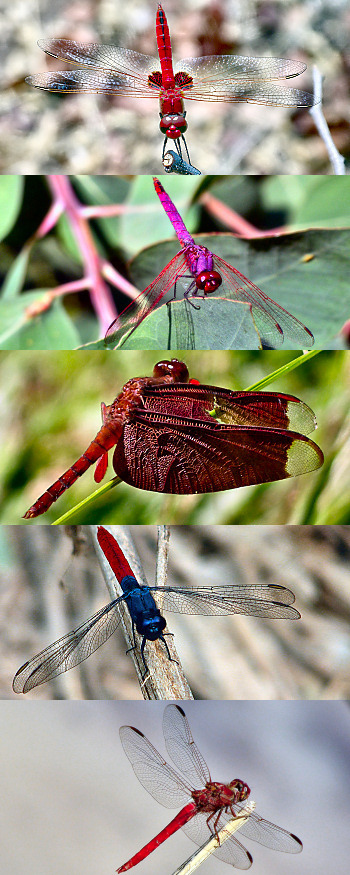
Red Dragonflies seen in (Top down): Zambia; Rwanda; Myanmar;
Brazil; Argentina
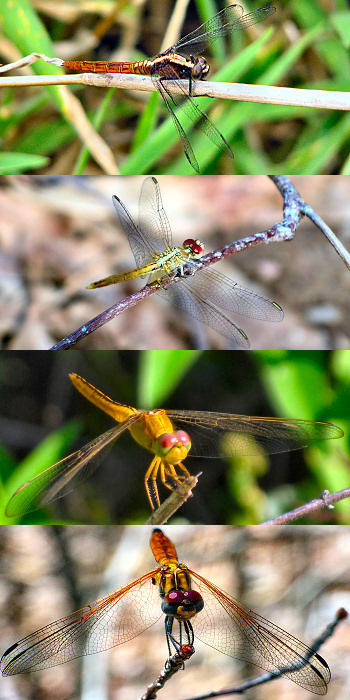
Golden Dragonflies seen in (Top down): Brazil; Australia; S. Lanka; Madag.
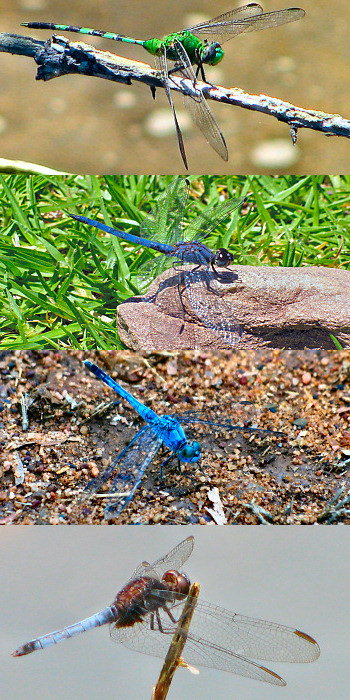
Green/Blue Dragonflies seen in (Top down): Galapagos; Lesotho;
Australia; Argentina
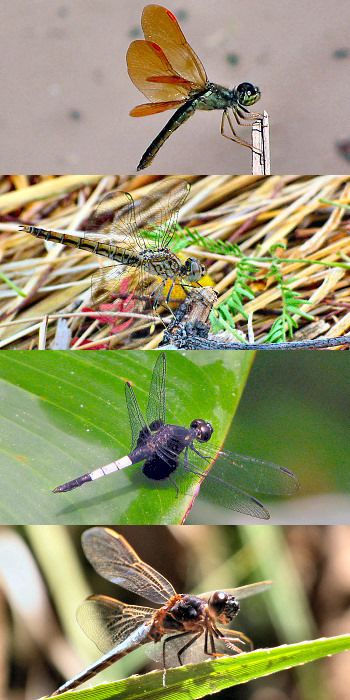
Miscellaneous Dragonflies seen in (Top down): Argentina; Botswana;
Peru; Australia
The closest relatives of the Dragonflies are the Damselflies. It is unfortunate that they are not as frequently seen as their cousins, as I find them, perhaps, even more attractive, with their slender bodies and graceful wings. The two shown below are the best examples of the handful that I saw.
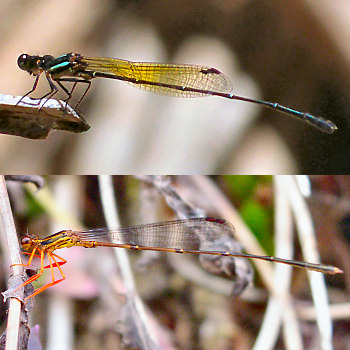
Damselflies seen in (Top down): Australia; Madagagascar
The Web-Weaver's World
Spiders may not be many people's favorites, though, if I ignore that fact that I invariably get their webs ensnarled in my face while walking through the forest, I find them rather appealing. Among the most conspicuous members of the Arachnid class are the Orb-Weaver Spiders, so named for the circular, or spiral, designs embedded in their webs. Some members of that family grow to a spectacularly impressive size, with leg spans similar in size to the palm of my hand. These giants also spin correspondingly large webs, and I have seen many cases where numerous spiders do so in a very small area, such as along a fence top, which provides a sight certain to offend squeamish personalities. However, though intimidating in appearance, the Giant Orb Weavers are generally harmless, and are content to sit motionless in their webs for most of the time. I have found that the best region to see these creatures is in the lands encircling the Indian Ocean, the heartland of Gondwana.
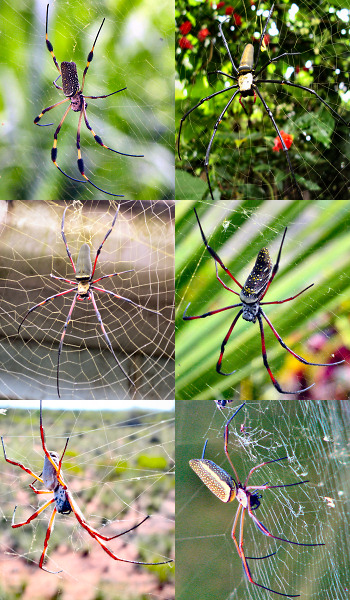
Giant Orb-Weaver Spiders seen in: Colombia | Papua New Guinea Row 1
Papua New Guinea | Madagascar Row 2
Australia | Peru Row 3
A much more diminutive example, though one just as intriguing, comes from the related family Gasteracantha, commonly known as the Spiny Orb Weaver Spiders. I first observed one of these bizarre-looking spiders on Papua New Guinea, and thought at the time that it must surely be the type of evolutionary oddity found only on such a tropical-forest-covered island. Much later, I saw similar spiders in Colombia and on the Islas Galapagos, and I now know that the genus is rather widespread, especially in the southern hemisphere and the Gondwanan fragments.
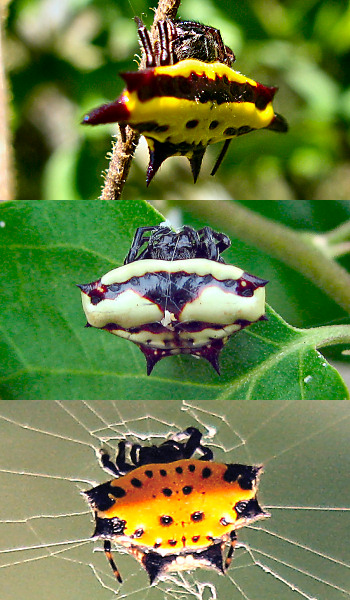
Spiny Orb-Weaver Spiders seen in (Top down): Papua New Guinea;
Galapagos; Colombia
Various other interesting examples from different families can be seen when one keeps an eye out for them. Below are two Argiope Spiders, also known as St. Andrew's Cross Spiders, thanks to the X-shapes they design into their webs, which I saw at locations in opposite hemispheres. Below those is a cute little fellow, a tiny member of the Jumping Spider family, Salticidae, from Brazil, that is reminiscent of something that might be seen a science fiction movie.
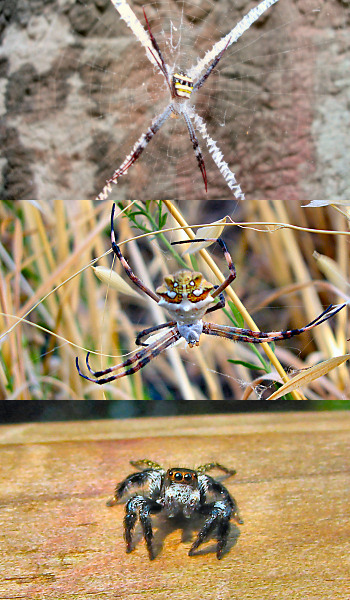
Two Argiope Spiders seen in: India (Top); Argentina (middle);
A Jumping Spider in Brazil (Bottom)
Certainly among the most impressive arachnids are the Tarantulas, with their large size, sturdy build, and fuzzy bodies. I had always assumed that they were strictly New World species, however, they are distributed across all temperate parts of Gondwana, and some northern-hemisphere locations as well. I am not sure if the second example in the image below, which I found lounging about on my tent one morning, is actually a member of the Theraphosidae family, though its appearance seemed similar to me. The Pink-Footed Tarantula, seen in the bottom panel, definitely is, and I saw that impressive creature in the forests surrounding the Yarapa River Lodge in the Peruvian Amazon.
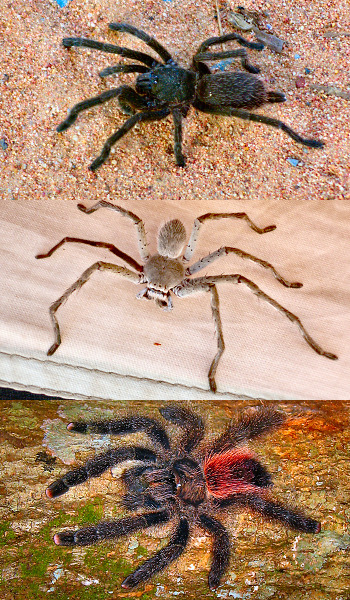
Large Spiders seen in (Top down): Myanmar; Argentina; Peru
Of course, spiders are famous primarily for their intricate webs, which add a touch of art to otherwise random landscapes. Here is an especially attractive example.
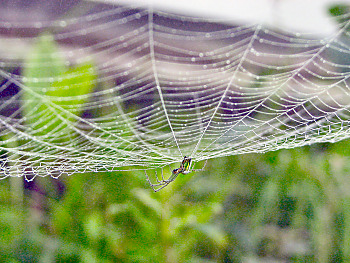
A spider weaves its Web in Ecuador
Brilliant & Bizzare Beetles
The order Coleoptera,
the beetles, may contain over 5 million species, though presumably no one knows exactly how many there are with any certainty. Therefore, even on a long tour through exotic lands, it is only possible to see a miniscule fraction of the order's diversity. Despite that, one is almost guaranteed to observe a few impressive examples along the way. However, many of the most dramatic cases are at their best when in flight, which makes getting a photograph of them close to impossible. Nevertheless, below are some of the more interesting types I saw during the Tour.
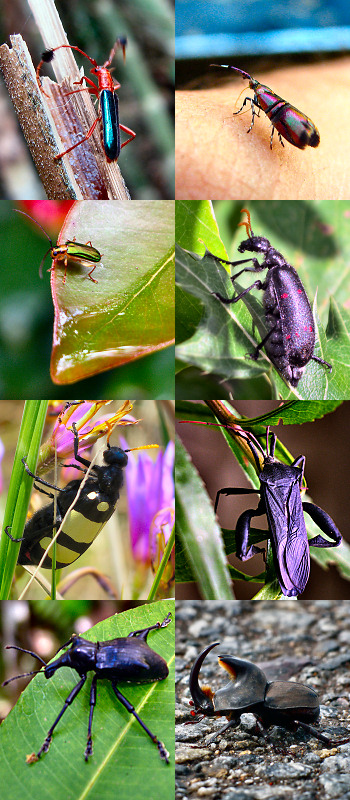
Beetles seen in: Brazil | Peru Row 1
Madagascar | Ethiopia Row 2
South Africa | Madagascar Row 3
Papua New Guinea | Argentina Row 4
Great Grasshoppers
Another group that surprised me with the outrageous colorations of some of its members was the Grasshoppers, and thier cousins, the Crickets. I had grown accustomed to plain green or brown examples commonly seen in the areas of North America where I have lived. However, in parts of Gondwana, such as Ethiopia, where there are large numbers and a wide variety of species, perhaps the source of ancient stories about plagues of locusts, many I saw were rather audacious in their displays of color. I also had previously thought of Grasshoppers as creatures of the open plains, and was once again surprised to see them in other environments, such as the rainforests of Peru.
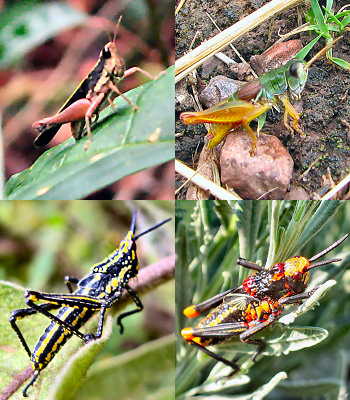
Small Grasshoppers seen in: Peru | Peru Row 1
Ethiopia | South Africa Row 2
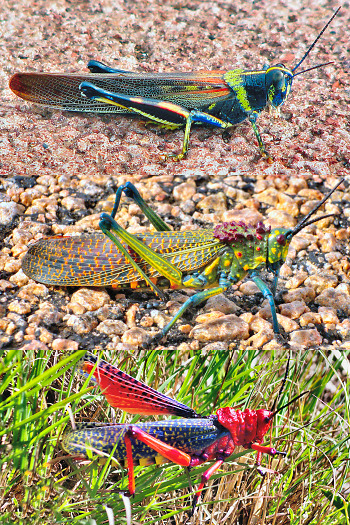
Large Grasshoppers seen in (Top Down): Galapagos;
Madagascar; South Africa
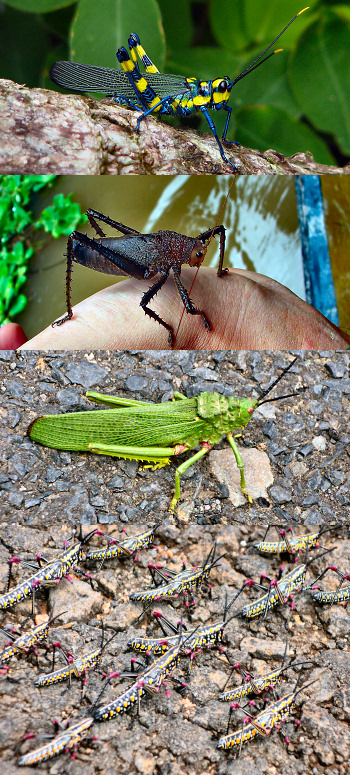
(Top Down) Large Grasshopper in Peru; A large Cricket in Peru
Large Grasshoppers seen in: Ethiopia; Ethiopia
The Unseen Society
One of the more ubiquitous resident insect families of Gondwana, though one very infrequently seen, is the Termites. In particular, while there are Termites in most parts of the World, the mound-building varieties are the true owners of Gondwana. Though they, or, more precisely, their homes, can be seen in various environments, it is in the tropical savannas where they are most abundant. I saw examples in every such region I visited, and in many cases the number of mounds stretching out across the plains was truly impressive. Australia, specifically the Northern Territory, was probably the best place to see the most immense examples of the creatures' constructions. One particularly relevant impact of their presence for me was that wherever mounds were common it was always easy for me to find a good spot to place my tent, thanks, presumably, to their detrivorous activities.
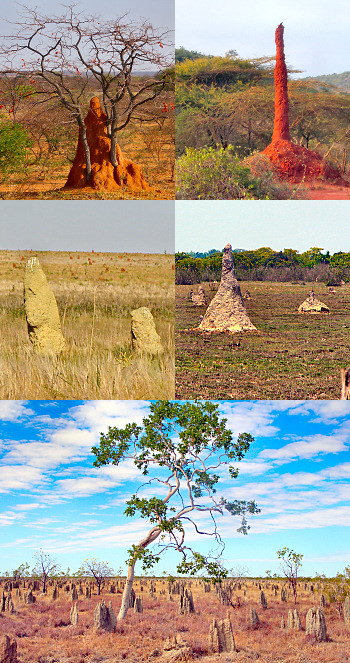
Termite Mounds in: Botswana | Ethiopia Row 1
Brazil | Colombia Row 2
Australia Row 3
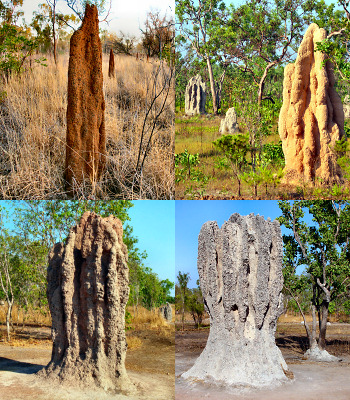
Four Giant Termite Mounds in the Northern Territory, Australia
The Stinging Bunch
Bees were sort of a yin-and-yang-type creature for me during the Tour. On one hand, I certainly appreciated their pollination efforts, which led to the profusion of wildflowers that kept my spirits high along the way. On the other hand, I was attacked by swarms of the creatures, without provocation on my part–twice. The first of those events occurred in Rwanda, and the second in Mexico. In both cases the attackers seemed to be incensed by the odors emanating from my sweat-soaked gloves and helmet. Though there was no significant harm done, I certainly did not enjoy those encounters, and that may have spoiled my opinion of the Bees as a whole. Wasps, on the other hand, despite their often-fearsome reputation caused me no harm during the Tour. While I saw them in numerous locations the most interesting were in Peru, including the blue and brown colored Tarantula Hawk Wasps, which, as their name suggests are predators on the big spiders, despite their smaller size. Though I never had any bad encounters with wasps, the guides from the Yarapa River Lodge were considerably anxious when we came across the nest shown in the bottom panel during one of our jungle treks.
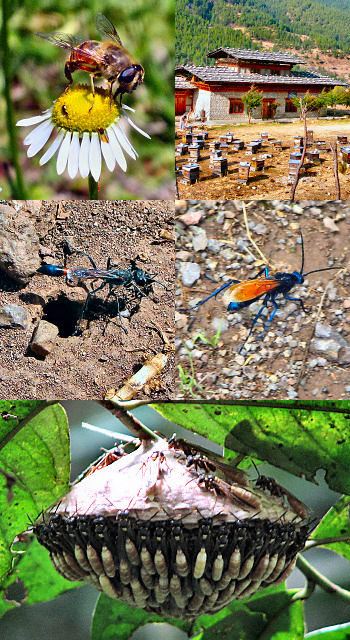
Bee on a flower in Lesotho | Beehives in Bhutan Row 1
Ground-dwelling Wasp in Peru | Tarantula Hawk Wasp in Peru Row 2
Wasp Nest in Peru Row 3
Sublime Lepidoptera
Perhaps the most popular type of insects, the butterflies, also provided a frequent dash of beauty during my Tour. Of course, one of the distinctive features of the order Lepidoptera is the multi-formed life cycles of its members and their corresponding metamorphoses. While the adult phase of these creatures is, properly, considered to be their most attractive form, the larval stage, as caterpillars, of many types are also rather brilliantly colored and patterned. This is often considered to be a defense mechanism, as it warns potential predators of the caterpillar's toxicity. Whether the examples below will transform intro equally attractive adults, I cannot say, but, if not they were still among the most unusual and interesting of the types I saw along the way.
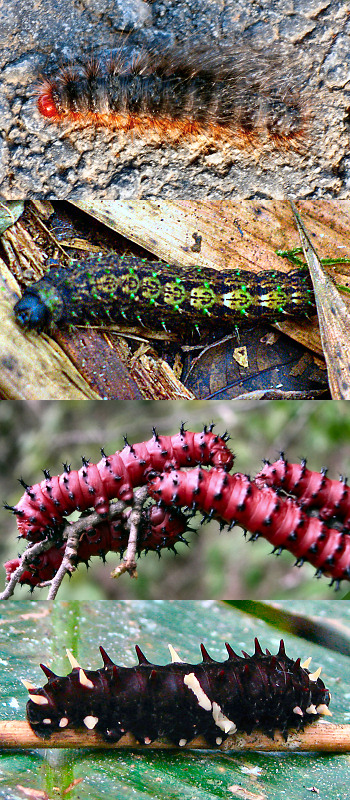
Caterpillars seen in (Top Down): South Africa;
South Africa; Madagascar; Peru
Many people overlook the Moths, due to a preference for their more charismatic cousins. However, while it cannot be denied that many Moths are plain brown, well camouflaged for hiding on trees, and spend much of their short lives battering themselves to bits by flying into porch lights, there are some surprisingly beautiful examples out there. I was surprised to find a large concentration of pretty individuals hanging around inside the visitor center at Parque National Ranomafana, in Madagascar. Especially notable were the Saturniids, or the Giant Silkworm Moths, and though they are found in most parts of the world I had never seen one until I reached that park. One of those I saw there, I later learned, was a member of the species Antherina Suraka.
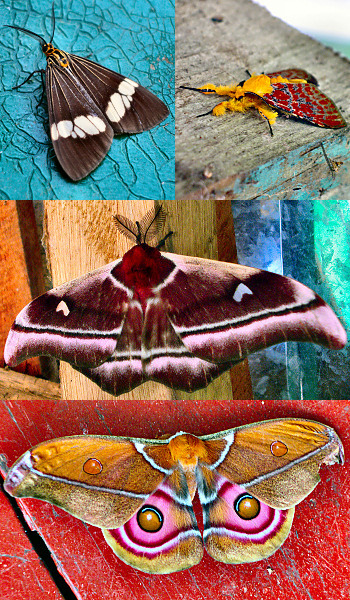
Moths seen in: Australia | Madagascar Row 1
Madagascar Row 2
Madagascar (Antherina Suraka) Row 3
Of course, the stars of the order are the butterflies, justifiably famous for their inherent beauty. To my pleasure, I was never far away from one type of Butterfly, or another, during the length of the Tour. Some areas were better than others for seeing them, and Southeast Asia and, especially, the area surrounding Iguazu Falls between Argentina and Brazil were the locations with the highest numbers of very beautiful types. I have seen theories stating that the early evolution of Butterflies occurred on Gondwana, and though it may be difficult to prove since the soft-tissued creatures probably never fossilized well, I would like to think that those ideas are correct. Below is a sampling of my favorite sightings of the Tour.
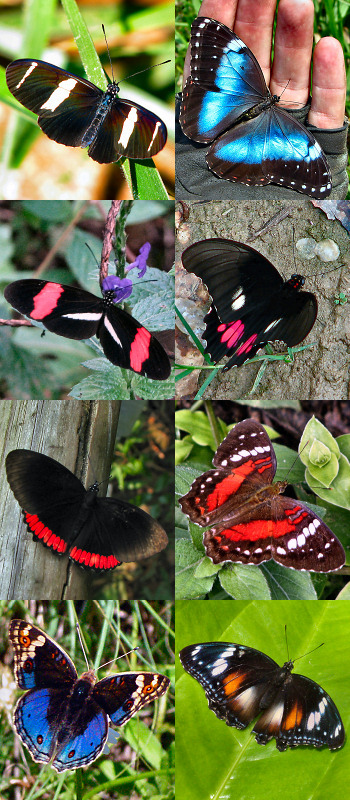
Butterflies seen in: Brazil | Argentina Row 1
Colombia | Peru Row 2
Argentina | Colombia Row 3
Lesotho | Australia Row 4
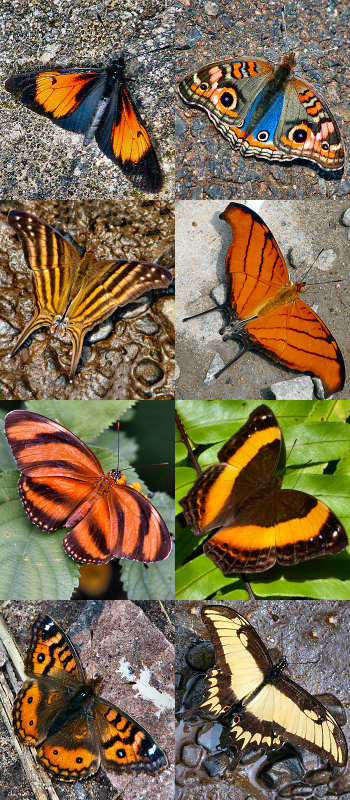
Butterflies seen in: Colombia | Paraguay Row 1
Argentina | Argentina Row 2
Colombia | Australia Row 3
Peru | Argentina Row 4
Oddities & Mimics
What could be odder than the Millipedes? Their body design surely makes them one of the most distinctive members of the arthropod world. Wherever they live, it is usually not hard to see them as they are rather slow moving and often take their time when crossing roadways. This places an additional burden on cyclists, and others, to steer clear when they are out and about. While Millipedes live in many parts of the world, the largest examples are found in Africa.
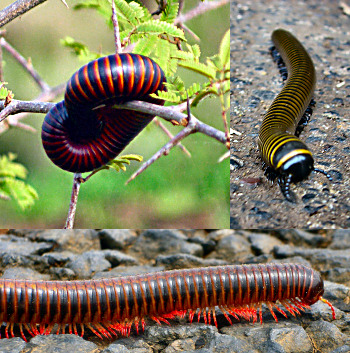
A Millipede resting in a tree in S. Africa | at Iguazu Falls, Brazil Row 1
South Africa Row 2
Of course, insects that have evolved appearances useful for camouflage are, by their very nature, hard to see. Nevertheless, when one is out in the World for a long time encounters with such creatures are bound to occur. The familiar Katydid in the image below, was perhaps the mimicking insect that was easiest for me to spot. Much more difficult was the Phasmid, or Stick Insect, in the second panel below. It is the "stick" that bisects the image horizontally that is the actual animal. Mantises also occasionally adopt disguises to varying degrees of effectiveness. The example in the third panel only moderately so, while the final image requires a careful look to identify the individual parts of the insect.
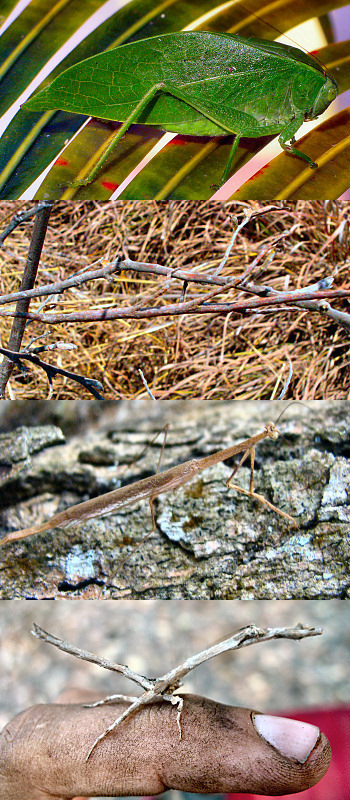
Camouflaged Insects (Top Down): Leaf mimic in Madagascar;
a perfectly hidden Phasmid in Madagascar; a small Mantis in Brazil;
a well-camouflaged Mantis in Zambia;
I honestly have no idea exactly what these little creatures are, perhaps ticks, mites, or spiders. Whatever their classification, I was lucky to come across them hiding beneath a tree branch in Madagascar, as their appearance when grouped together causes them to resemble the local lichens.
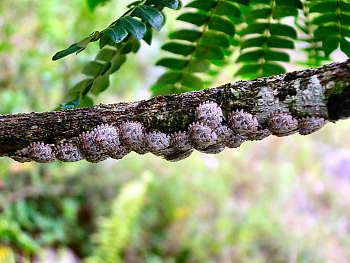
Giant Tick-Like Insects hiding beneath a branch in Madagascar
Also in Madagascar lives a curious type of water skimming insect, which I have seen examples of on two tours. Unlike the water bugs I have been familiar with from childhood, which make use of their widely spaced feet to avoid breaking the surface tension of the water on which they stand, these insects use a different method for moving across the water's surface. Their shell, about the same size and shape as a half of an almond, presumably traps a bubble of air, which serves to keep them afloat. Their legs then provide propulsion, and rapidly zip them about on the surface of ponds and creeks in a most entertaining way.
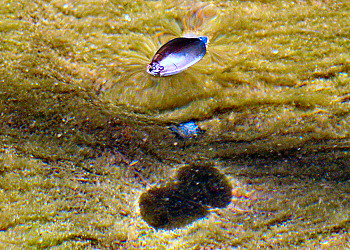
A Boatman's Waterbug in Madagascar
Here is another one that I could not identify initially. Is it a beetle, a butterfly, or something else? I found its odd appearance rather appealing as it walked across the deck of a riverboat in the Pantanal of Brazil, and only later learned that it is a Treehopper, of the family Membracidae. That impressive family contains many bizarrely-shaped and colorful members.
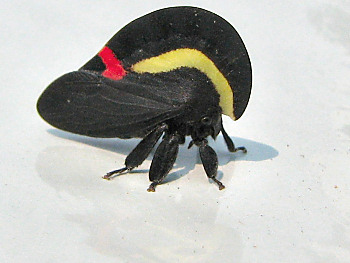
A Treehopper in the Pantanal of Brazil
Perhaps the most excellent example of mimicry was seen in Madagascar, once again. There, while visiting Parque National Isalo, my guide pointed out a rather typical looking, but attractive, tree branch which seemed about to open up a number of flower buds.
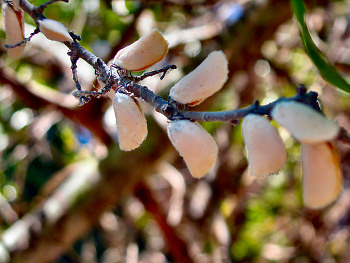
An interesting Tree Branch in Madagascar
Usually, I prefer to visit natural attractions alone without a guide, but sometimes having a local expert along really pays off. In that case, I was instructed to look more closely, and soon discovered that what appeared to be flower buds were, in fact, insects. I now know that they were Flatid Leaf Bugs, Phromnia Rosea. What a superb example of an evolved disguise. It required both the evolution of a form that resembled a leaf or flower bud, and the coordinated behavior of the insects to align themselves properly on ordered rows along a bare branch. This observation provided one of my more memorable natural experiences of the Tour.
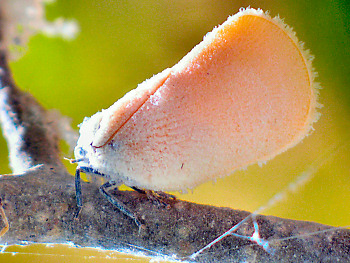
A Flatid Leaf Bug
All of these creatures added beauty and enjoyment to my Tour. Not all were as beneficial, however. If there is one creature on Earth that I would not be sad to see go extinct, it is the Bush Flies, Musca Vetustissima, that inhabit Australia, and their slightly less despicable cousins around the Indian Ocean basin. Though they certainly were a huge nuisance during the Tour, the more appealing Arthropods I saw, many of which I have listed on this page, more than made up for that.
Previous | Next
Main Index | Pre-Tour Index
Post-Tour Index | Articles Index
Slideshows
Main Index Pre-Tour Post-Tour Articles Previous Next |
For Further Reading
I don't have anything especially insightful or interesting to place in this section. So, for more information, here are links to Wikipedia pages for the groups pictured on this page.
~ Dragonflies
~ Damselflies
~ Orb Spiders
~ Spiny Orb-Weaver Spiders
~ Argiope Spiders
~ Tarantulas
~ Beetles
~ Grasshoppers
~ Termites
~ Bees
~ Wasps
~ Moths
~ Butterflies
~ Milipedes
~ Katydids
~ Stick Insects
~ Mantis
~ Treehoppers